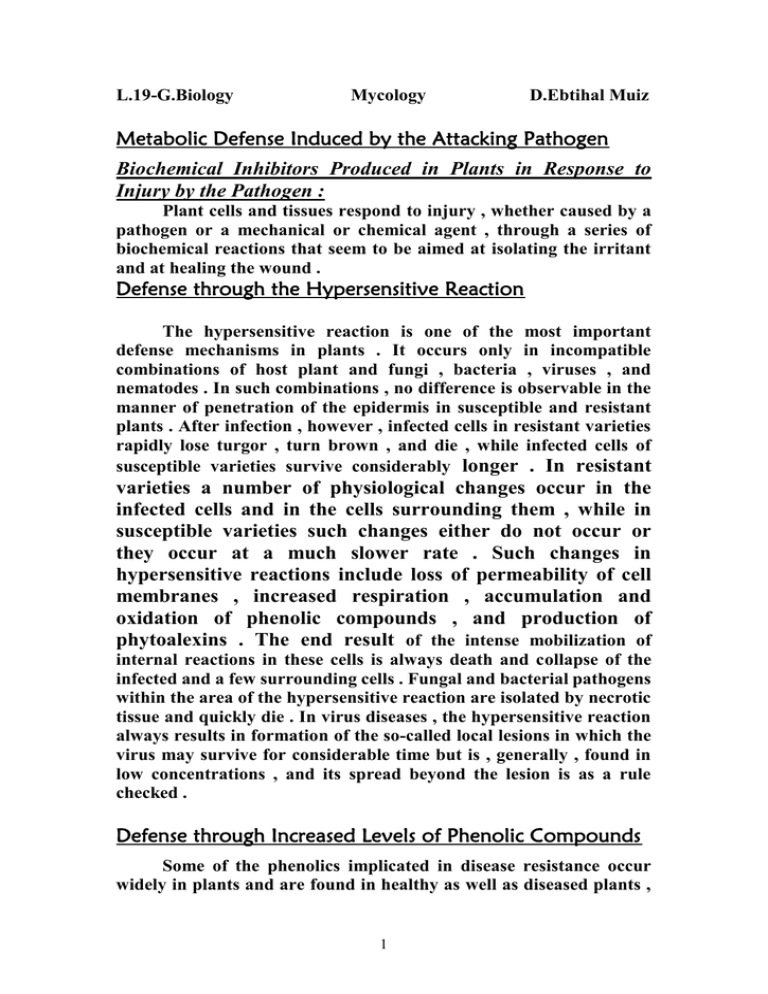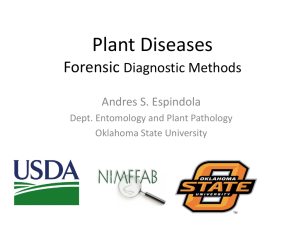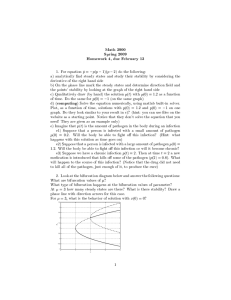Metabolic Defense Induced by the Attacking Pathogen
advertisement

L.19-G.Biology Mycology D.Ebtihal Muiz Metabolic Defense Induced by the Attacking Pathogen Biochemical Inhibitors Produced in Plants in Response to Injury by the Pathogen : Plant cells and tissues respond to injury , whether caused by a pathogen or a mechanical or chemical agent , through a series of biochemical reactions that seem to be aimed at isolating the irritant and at healing the wound . Defense through the Hypersensitive Reaction The hypersensitive reaction is one of the most important defense mechanisms in plants . It occurs only in incompatible combinations of host plant and fungi , bacteria , viruses , and nematodes . In such combinations , no difference is observable in the manner of penetration of the epidermis in susceptible and resistant plants . After infection , however , infected cells in resistant varieties rapidly lose turgor , turn brown , and die , while infected cells of susceptible varieties survive considerably longer . In resistant varieties a number of physiological changes occur in the infected cells and in the cells surrounding them , while in susceptible varieties such changes either do not occur or they occur at a much slower rate . Such changes in hypersensitive reactions include loss of permeability of cell membranes , increased respiration , accumulation and oxidation of phenolic compounds , and production of phytoalexins . The end result of the intense mobilization of internal reactions in these cells is always death and collapse of the infected and a few surrounding cells . Fungal and bacterial pathogens within the area of the hypersensitive reaction are isolated by necrotic tissue and quickly die . In virus diseases , the hypersensitive reaction always results in formation of the so-called local lesions in which the virus may survive for considerable time but is , generally , found in low concentrations , and its spread beyond the lesion is as a rule checked . Defense through Increased Levels of Phenolic Compounds Some of the phenolics implicated in disease resistance occur widely in plants and are found in healthy as well as diseased plants , 1 but their synthesis or accumulation seems to be accelerated after infection . Such compounds may be called " common " phenolic compounds . Certain other phenolics, however , are not present in healthy plants but are produced upon stimulation-by a pathogen or by a mechanical or chemical injury . Such compounds are known as phytoalexins . " Common " phenolic : It has often been observed that certain " common " phenolic compounds that are toxic to pathogens are produced and accumulate at a faster rate after infection in a resistant variety of plant than in a susceptible variety . Chlorogenic acid , caffeic acid , and scopoletin are examples of such phenolic compounds ( Figure 5 - 8 ) . Although some of the common phenolics may each reach concentrations that could be toxic to the pathogen , it should be noted that several of them appear concurrently in the same diseased tissue , and it is possible that the combined toxic effect of all fungitoxic phenolics present , rather than that of each one separately , is responsible for the inhibition of infection in resistant varieties . Phytoalexins : Phytoalexins are toxic substances produced in appreciable amounts in plants only after stimulation by the various types of phytopathogenic microorganisms or by chemical and mechanical injury . Phytoalexins are produced by healthy cells adjacent to localized damaged and necrotic cells in response to materials diffusing from the damaged cells . Phytoalexins are not produced during biotophic infections . Phytoalexins accumulate around both resistant and susceptible necrotic tissues . Resistance occurs when one or more phytoalexins reach a concentration sufficient to restrict pathogen development . The Role of Induced Synthesis of Enzymes Pathogen attacks on plants appear to induce alterations in enzyme synthesis in the plant that can lead to the development of various degrees of resistance around infection sites . An enzyme that generally exhibits increased activity or greater new synthesis in diseased tissues is phenylalanine ammonia lyase ( PAL ) . PAL is a key enzyme in the production of the basic molecule used for the biosynthesis of most phenolics , including phytoalexins and lignin . The resistance of plants to the pathogen may depend on the speed and extent of synthesis of one or more enzymes induced in the host by 2 the pathogen or closely related nonpathogens . This type of defense seems to be related to that afforded by increased amounts of common phenolics , phytoalexins , and other compounds , the additional enzymes being those required for synthesis of phytoalexins , although it is possible that the two mechanisms operate separately . Defense through Formtion of Substrates Resisting the Enzymes of the Pathogen Plant resistance to some pathogens is apparently a result of the presence or appearance of compounds that are not easily degraded by the enzymes of pathogens attempting to invade the plant . These compounds are usually complexes between pectins , pr0teins , and polyvalent cations such as calcium or magnesium . The availability or accumulation of either cation near the infection results in formation of pectin salts or other complexes that resits degradation by the pathogen enzymes . Thus they inhibit tissue maceration and confine the pathogen to lesions of limited size . The effectiveness of impregnation of cell walls and papillae with ligninlike substances against invading pathogens was mentioned previously . Defense through Inactivation of Pathogen Enzymes Several phenolic compounds or their oxidation products seem to induce resistance to disease though their inhibitory action on the pectolytic and other enzymes of the pathogen rather than on the pathogen itself . In some diseases the more resistant the varieties or the tissues , the higher is their content in polyphenols , and although these phenols do not inhibit the growth of the pathogen , they do inhibit the activity of its pectionlytic enzymes and apparently contribute to the resistance of the plant . The resistance of many young immature fruit to fungal infection , for example m apple to Monilinia and grape to Botrytis m seems to be the result of their high content content of such enzyme-inhibiting phenolic compounds The polygalacturonase of the fungus Diplodia , causing post-harvest decay of oranges , is inhibited by a protein produced by cells in the rind , but the role of this protein in disease resistance has not been established . The Role of Induced Synthesis of Enzymes Pathogen attacks on plants appear to induce alterations in enzyme synthesis in the plant that can lead to the development of various degrees of resistance around infection sites . An enzyme that 3 generally exhibits increased activity or greater new synthesis in diseased tissues is phenylalanine ammonia lyase ( PAL ) . PAL is a key enzyme in the production of the basic molecule used for the biosynthesis of most phenolics , including phytoalexins and lignin . The resistance of plants to the pathogen may depend on the speed and extent of synthesis of one or more enzymes induced in the host by the pathogen or closely related nonpathogens . This type of defense seems to be related to that afforded by increased amounts of common phenolics , phytoalexins , and other compounds , the additional enzymes being those required for synthesis of phytoalexins , although it is possible that the two mechanisms operate separately . Defense through Formtion of Substrates Resisting the Enzymes of the Pathogen Plant resistance to some pathogens is apparently a result of the presence or appearance of compounds that are not easily degraded by the enzymes of pathogens attempting to invade the plant . These compounds are usually complexes between pectins , pr0teins , and polyvalent cations such as calcium or magnesium . The availability or accumulation of either cation near the infection results in formation of pectin salts or other complexes that resits degradation by the pathogen enzymes . Thus they inhibit tissue maceration and confine the pathogen to lesions of limited size . The effectiveness of impregnation of cell walls and papillae with ligninlike substances against invading pathogens was mentioned previously . Defense through Inactivation of Pathogen Enzymes Several phenolic compounds or their oxidation products seem to induce resistance to disease though their inhibitory action on the pectolytic and other enzymes of the pathogen rather than on the pathogen itself . In some diseases the more resistant the varieties or the tissues , the higher is their content in polyphenols , and although these phenols do not inhibit the growth of the pathogen , they do inhibit the activity of its pectionlytic enzymes and apparently contribute to the resistance of the plant . The resistance of many young immature fruit to fungal infection , for example m apple to Monilinia and grape to Botrytis m seems to be the result of their high content content of such enzyme-inhibiting phenolic compounds The polygalacturonase of the fungus Diplodia , causing post-harvest decay of oranges , is inhibited by a protein produced by cells in the rind , but the role of this protein in disease resistance has not been established . 4







